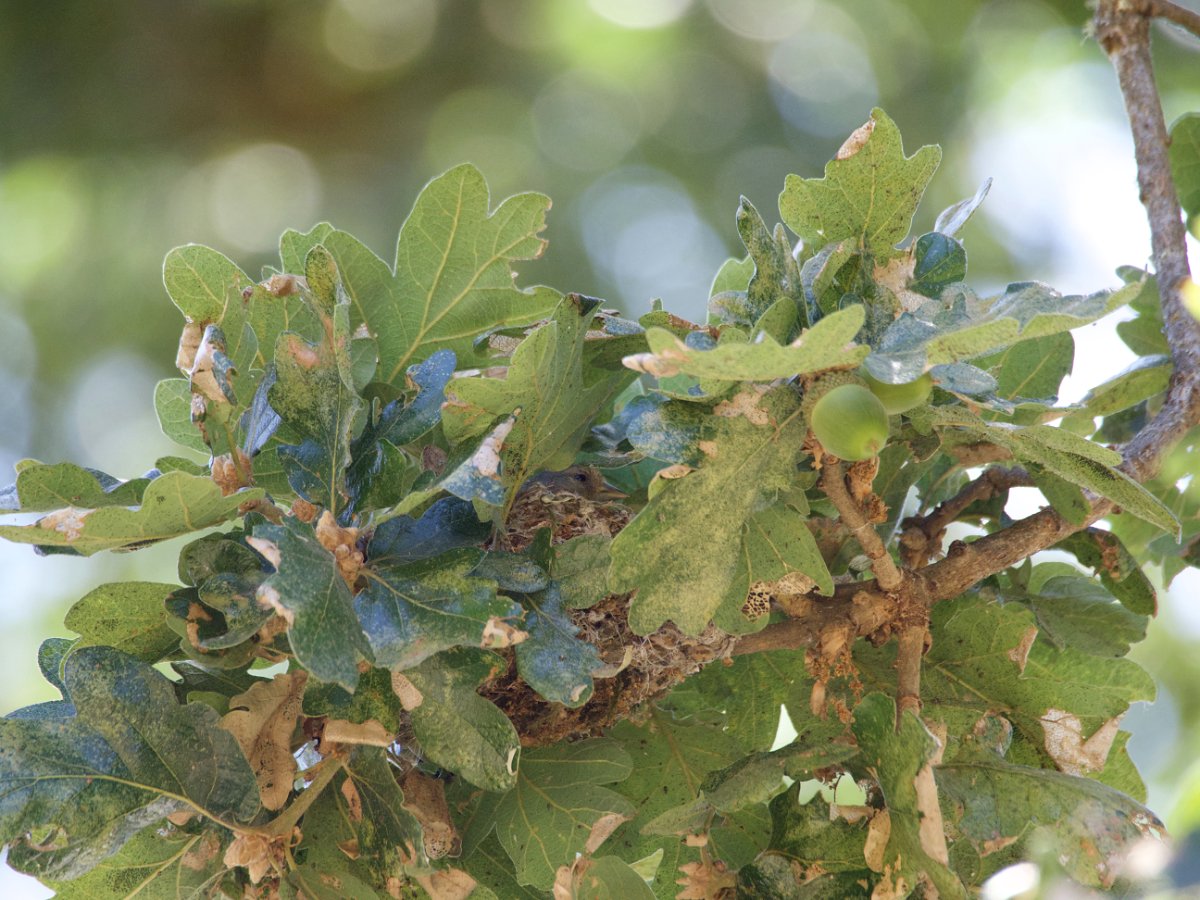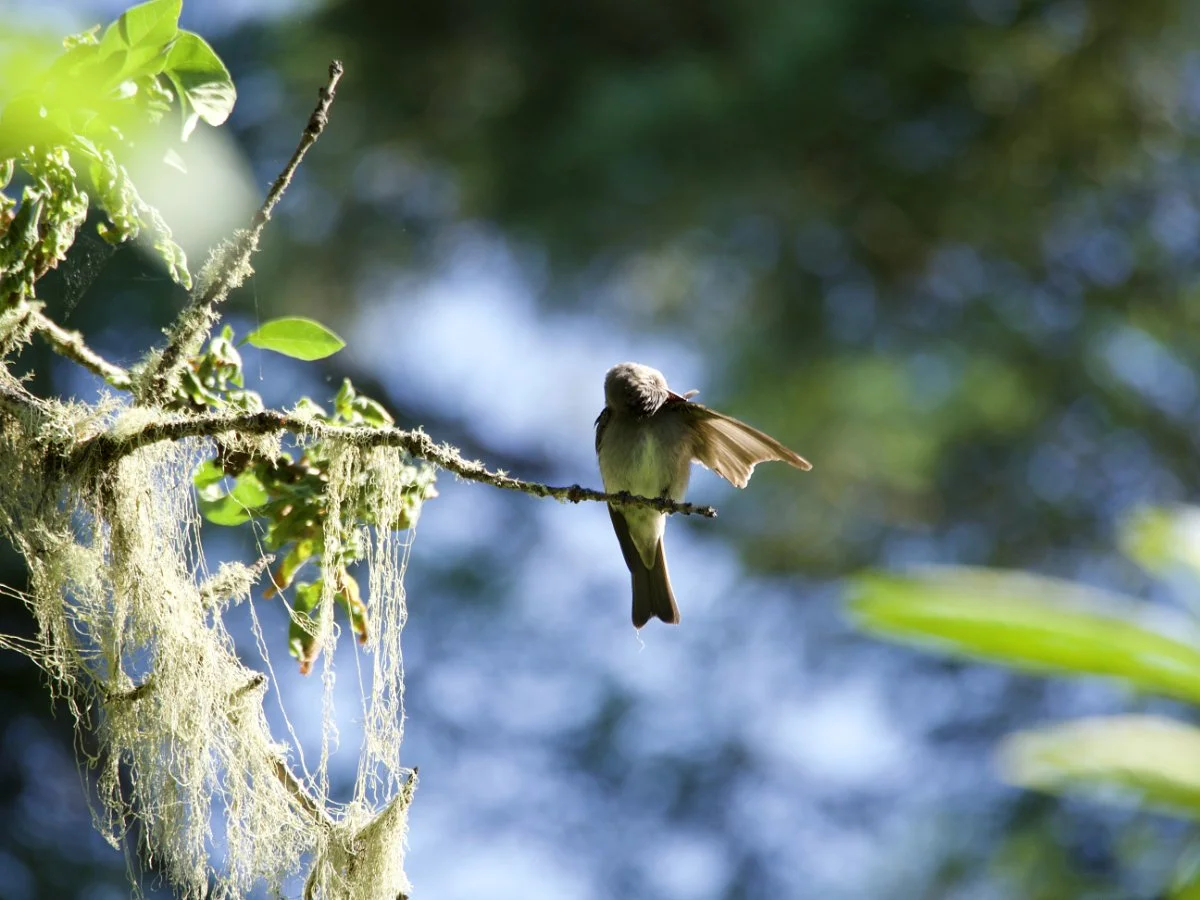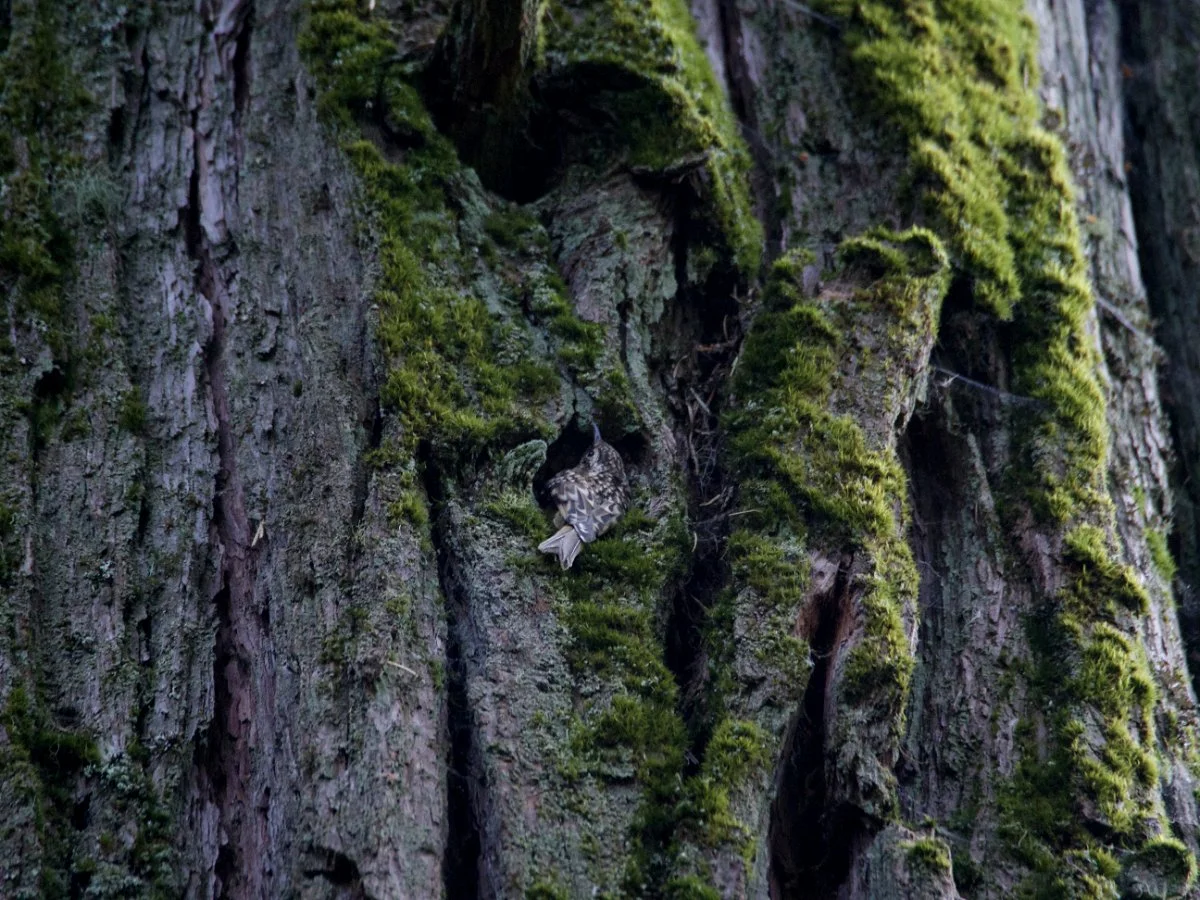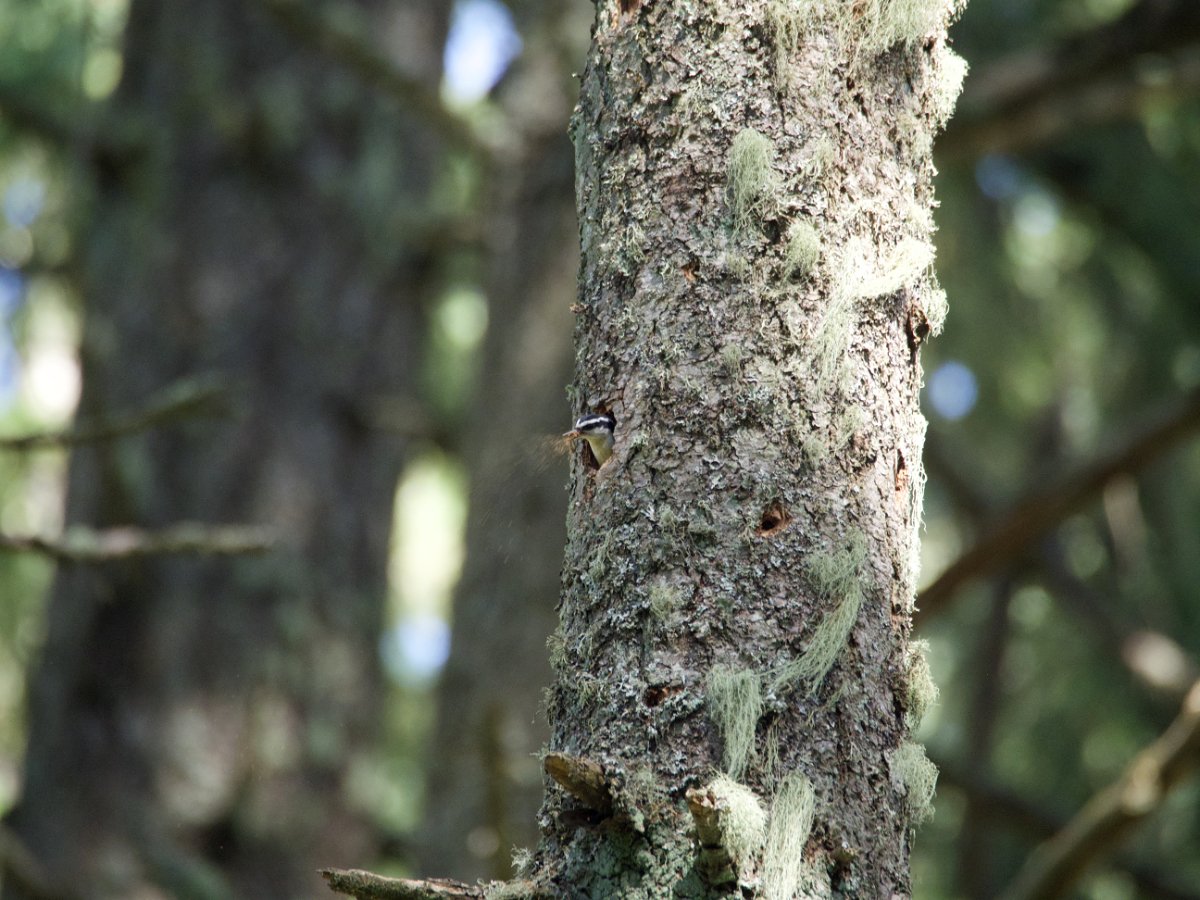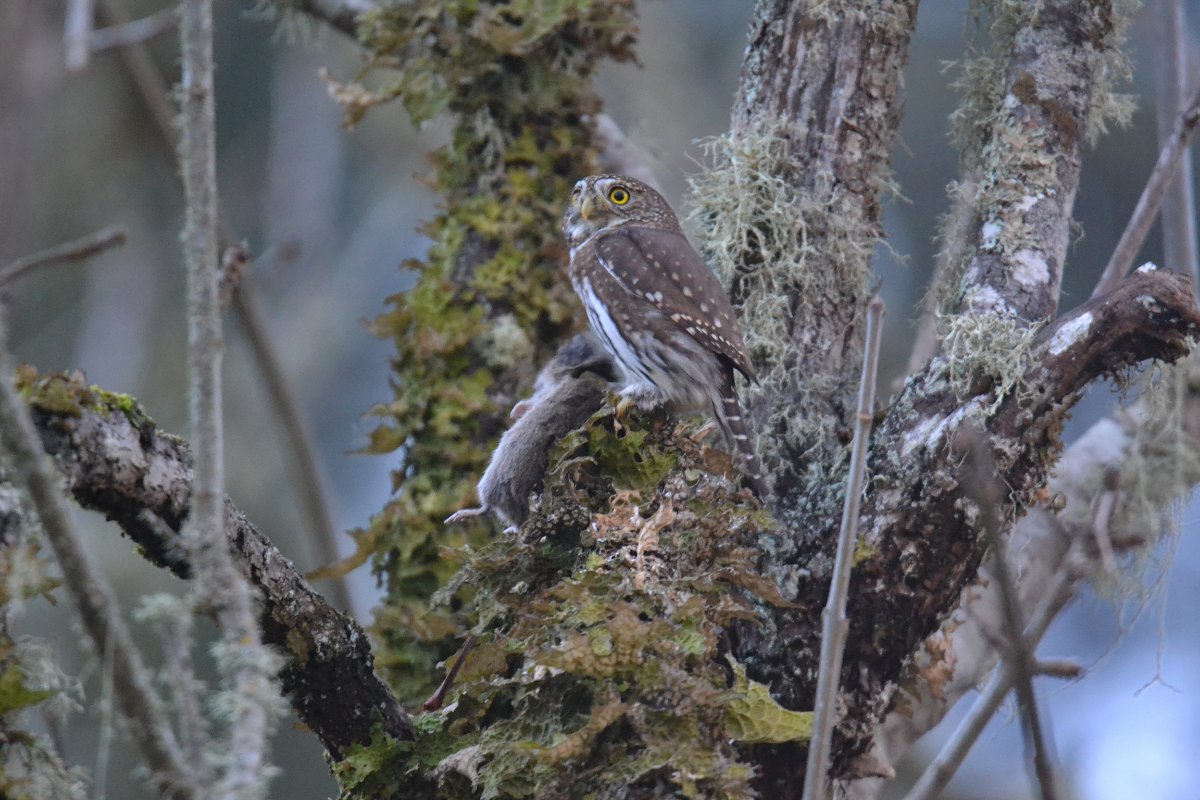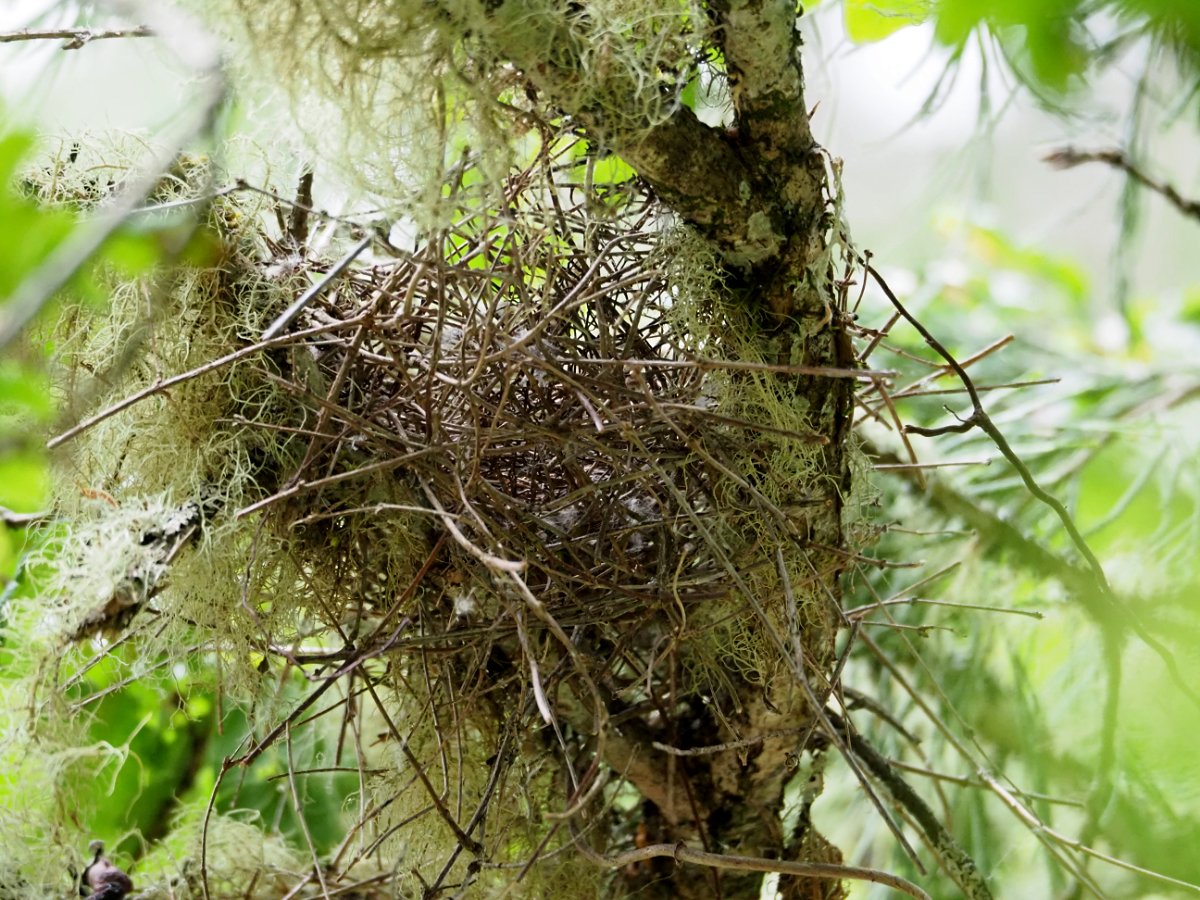While picking up trash by the river, I came across a pile of flicker feathers under a small thicket of willows. It was a mix of emotions to find them—saddened to see that a beautiful bird had been killed and fascinated at the beauty and patterns of all the feathers. It was also a mystery. There were so many feathers. It was like the predator took the time to neatly pluck all of the feathers out before it ate the flicker. There wasn’t any sign of the body of the bird and there wasn’t any blood on the ground or on any of the feathers. It felt like the predator recognized the beauty of the bird and wanted to honor the life it had taken by carefully plucking the feathers to preserve their beauty.
Lesser Goldfinch
I have been watching a Lesser Goldfinch nest for the last three and half weeks. The nest is neatly tucked in a cluster of leaves at the end of an oak branch. There are two baby birds still in the nest.
It is thought that goldfinches are late season nesters in order to take advantage of all of the seeds. The parents regurgitate a mushy seed-porridge to the babies during nesting. Also, I imagine that the timing is beneficial for the juvenile birds to have a bountiful crop of seeds to eat when they leave the nest.
The meadows around the pavilion are full of grass seeds that the goldfinches love. It is fun to watch them forage. They will land on a grass stalk and move towards the seed head. This bends the stalk over where they can access the seeds and they can often be seen hanging upside down eating. Birds are acrobatic creatures.
You have to be observant and moving slowly to catch the goldfinches nibbling on seeds. They practically disappear in the dry meadow colors and the dappled sunlight under the oak trees. It is not uncommon for me to flush them out of the grass as I walk along. Many times they won’t go far and are usually fairly tolerant of my presence as I slowly inch closer to watch them.
Hope you are getting in some good birding this summer. Thanks for reading my blog.
Western Wood Pewee Sunning & Preening
In the early warmth of the morning sun, I watched this Western Wood Pewee sunning and preening. It spent most of the time with its back to the sun with its tail feathers spread out and its wings slightly open and away from its body. After a five minutes or so of sunning, it would have a session of preening that lasted approximately five minutes. Sometimes when it preened, it would flip around and have its other side exposed to the sun.
Occasionally an irresistible insect would fly by and it would swoop out, catch it, return to the perch, and continue preening. To my surprise, this lasted for around an hour.
I wrote about this sunning and preening last year, observing it in Robins and Steller’s Jays (Sunning, Feb. 28, 2024): This maintenance behavior isn’t completely understood but seems to be largely associated with removing parasites, such as lice, living on their skin and feathers. Studies have shown that exposing the feathers to direct sunlight can allow them to heat up enough to kill some of the lice. In addition, lice might move to escape the heat possibly making it easier to clear them away during preening, which often follows a session of basking in the sun.
Happy Birding!
Sweet Dreams
I was out walking around the arboretum the other evening enjoying the cool air and a slight breeze as the day was coming to a close. I was walking along the incense cedar trail and could hear the ethereal notes of brown creepers flowing through the forest. I stopped to listen and saw one swoop down to the base of a tree. I watched it for a little while as it sang and moved around on the furrowed trunks of old incense cedars looking for food. I lost sight of it in the waning light, but I could still hear it singing in the canopy. Suddenly it swept down to the base of an incense cedar in front of me. It went up the tree and came to a small cavity in the bark where a tree limb used to be. It hopped into the entrance and perched there. I watched as it sat there looking around. After about five minutes or so, I saw it nestle a little more into the old knot hole. I occasionally saw it gently close its eyes for a moment and then reopen them. I began to wonder if this was where this brown creeper was going to spend the night. I decided to sit down, wait for night to fall, and see if it stayed. I watched it over the next forty-five minutes or so, occasionally glancing up to see if it was still there. The last time I looked up there I saw that it had tucked its head inside, and I imagined that it had nodded off to sleep. So I said goodnight, quietly stood up, and walked on to go home and do the same.
Great Horned Owl - Thermoregulation
In the later part of spring, there was a hot weekend where the temperature got up to around 90 degrees Fahrenheit. It was the first day of the year where it had become that hot and it felt like summer had suddenly arrived in a blast of heat. I felt a bit drained from the surge in temperature and was staying in the shade as I walked around the arboretum. I was at the beginning of the zigzag trail when I heard a robin alarming on the hillside and went to check it out. I found two great horned owls—a parent and a juvenile. They were briefly on the same branch together and then the parent flew a little ways down the hillside. The juvenile stayed behind and I could see that it was eating a northern flicker. As it sat on the branch, it was occasionally making a screeching call that seemed to be a begging communication to the parent and to me, a possible signal that it was uncomfortable in the heat.
To remedy the stress from the heat It was perched in the deep shade of the hillside where it was coolest. It was also cooling itself by holding its wings open to allow the air to circulate over its body. I could also see that it was holding its mouth open and vibrating its neck. Some birds will perform a version of avian panting called gular fluttering where they open their mouths and vibrate their neck muscles to try and remove excess heat. Basically, opening their mouth and fluttering their neck muscles (in the throat or “gular” region) increases blood flow and moves air across the moist membranes in their mouth and esophagus, resulting in evaporative cooling.
As the daytime highs are consistently rising into the 90’s, I recommend fluttering your feet around in the river. Stay cool everybody. I hope to see you out there!
Resources
How Birds Keep Their Cool | Audubon. 1 Aug. 2012, https://www.audubon.org/news/how-birds-keep-their-cool.
How Do Birds Keep Cool in the Summer? | U.S. Fish & Wildlife Service. 11 Jun. 2021, https://www.fws.gov/story/how-do-birds-keep-cool-summer.
Western Wood-Pewee Nest
The nest of the Western Wood-Pewee is so elegant. It is tightly woven out of fine plant fibers and held together by spider webs. It is a work of art. I love watching the parent sitting on the nest as the branch gently sways in the breeze.
As I sit and watch this nest, it all seems unbelievable. This little bird flies all the way from South America to nest here at the arboretum! The range maps have them breeding in Western Canada and up into Alaska. The migration of birds is truly miraculous. I can’t even imagine all of the landscapes and obstacles this bird had to navigate to get here. And by the end of the summer, they will be on their way back along with the new hatchlings! That is a long way from here. This blows my mind!
Brood Patch
I found a pair of violet-green swallows nesting in a natural cavity of an Oregon ash tree. There were small, dead branches right outside of the entrance that made the perfect perch. As the female landed and began to preen her feathers, I could see that she had developed a brood patch.
For an egg to develop normally and hatch, a certain temperature range must be maintained. One of the ways birds achieve this is by sitting on the eggs and incubating them. To help facilitate the transfer of heat from the parent to the egg, birds temporarily develop a bare patch of skin on their belly called a brood patch. Certain hormones are produced that cause the feathers to fall out in this spot and to create additional blood vessels in the bald area to help transfer warmth to the eggs. Some birds, such as ducks and geese, may pluck their feathers to create a brood patch. The feathers that are shed can also be used to insulate the nest to help with temperature regulation. The time spent incubating eggs varies based on the insulating properties of the nest and the temperature of the environment. The bird can sense the temperature of the eggs through its brood patch and will adjust its time spent incubating the eggs accordingly. Birds will also periodically turn the eggs to warm them evenly and prevent the embryo from sticking to the shell.
Nature is an inexhaustible source of wonder. I hope to see you out there.
Resource
Ehrlich, Paul R., et al. The Birder’s Handbook: A Field Guide to the Natural History of North American Birds Including All Species That Regulary Breed North of Mexico. Simon & Schuster, 1988.
Blue-gray Gnatcatcher
The blue-gray gnatcatcher is a beautiful, little bird. The male is blue-gray above and white below. He has a white eye-ring and a black line that starts above one eye and curls around the forehead to above the other eye. The females are gray above and white below with the same striking eye-ring. They both have dark tails with white outer tail feathers.
This is a fun bird to watch flitting around through the landscape. When it perches, it has a noticeable behavior of cocking its tail, slightly fanning out the feathers, and swaying or wagging it back and forth.
Its nest is an open cup that is woven with small fibers and decorated with bits of lichen or bark. It looks similar to a hummingbird nest. Peterson has the length of the blue-gray gnatcatcher at 4.5 inches and Cornell lists it as 3.9 - 4.3. So they aren’t much bigger than a hummingbird.
The range map on All About Birds by the Cornell Lab doesn’t have them this far north, but lots of birds are expanding their range northward. This bird’s breeding range covers a lot of the United States from coast to coast. There is a small band across the lower part of the country where it can be seen throughout the year. Check out the range map at Cornell.
This bird is small and can be challenging to spot, so it’s helpful to also stay tuned into its vocalizations to find it. I love checking out how Roger Tory Peterson describes its voice in his Field Guide to Birds of Western North America. Here’s what he says: “Call a thin, peevish zpee; often doubled, zpee-zee. Song a thin, squeaky, wheezy series of notes.”
Happy birding! I hope to see you out there.
Western Kingbird Nesting
For reasons I don’t understand, kingbirds have chosen to nest on one of the high voltage towers out at the arboretum. The sound of the electricity crackling across the wires is audible from a fair distance. Never mind that the sound of sizzling is loud up there where they are nesting, being that close to high voltage electricity I imagine is not good for their health and the health of their babies. On top of that, I feel like those metal beams would heat up pretty hot in the noon day, summer sun. Again, I can’t believe that this would be an attractive site for them to nest. Trying to put a positive spin on it, I thought that they certainly won’t have to worry about ground predators like snakes and squirrels. Also the view is probably nice from up there and that will come in handy to detect and chase off predatory birds such as owls, ravens, crows and hawks that are in the area. It also looks fun as they dive off the tower and glide down to the hillside to forage.
They have a light gray head and a white breast that fades into a yellow wash on their bellies. They have a stout bill and a black tail with outer tail feathers.
They are a beautiful bird to observe and they love the open landscape of the east side of Mount Pisgah. I see them perching on top of brush piles and on dead limbs of shrubs like buckbrush. They are mainly insectivores and they will use these perches to forage by hawking insects out of the air or flying down to the ground.
Listen for their vocalizations. Peterson describes their voice as “shrill, bickering calls; a sharp kip or whit-ker-whit; dawn song pit-PEE-tu-whee.” I feel like Peterson always has interesting descriptions of a bird’s songs and calls. Check it out and see what you think.
I hope that you are getting in some birding time this spring. Nature is an inexhaustible source of wonder. I hope to see you out there.
Sources
Peterson, Roger Tory. Peterson Field Guide to Birds of Western North America, Fourth Edition. Houghton Mifflin Harcourt (HMH), 2010.
Western Kingbird Overview, All About Birds, Cornell Lab of Ornithology. https://www.allaboutbirds.org/guide/Western_Kingbird/overview. Accessed 30 May 2025.
Red-breasted Nuthatch Excavating Cavity
In my experience out at the arboretum, red-breasted nuthatches excavate their cavities and white-breasted nuthatches use existing natural cavities or nest boxes. This red-breasted nuthatch is working away on a Douglas-fir snag. I could hear the muffled hammering as it carved away. After a minute or less, it would appear in the entrance to the cavity with a mouthful of shavings. Sometimes it released the shavings from the entrance and sometimes it would pop out onto the side of the tree and let them go. The wood appears to have become very soft as the shavings looked like dust falling through the air. I think the nuthatch was excited about the consistency of the wood. It seemed to be vigorously and merrily chiseling away its new nest and it occasionally gave a toot from the entrance which sounds like a miniature tin horn. The male and female both excavate the nest with the female doing more. That said, the bold markings on this one appear to be the male, and males without mates may begin excavating several cavities at once in an attempt to attract a female. I need to go back and see if this male is in a relationship. After the cavity is constructed, she will line the bottom with soft materials such as fine grasses, strips of bark, fur, or feathers. Interestingly, I read that they will spread sap around the entrance to their nests. I love this little bird! I hope you are getting in some good birding so far this spring.
Northern Pygmy Owl
I had been wandering around for a while on Saturday afternoon, and I thought the birding had been pretty quiet. The weather was cool and a little rainy off and on. Thus, I found myself exploring the world of mosses which abound throughout the arboretum. This had me moving at a snail’s pace, which allowed me to be more tuned into my awareness and to make greater observations.
I was on the meadow’s edge near the White Oak Pavilion when a chickadee grabbed my attention. Its vocalizations seemed more intense as it broke the quietness of the late afternoon. As I watched and listened, I thought the notes had a different rhythm. Also, they were being repeated fairly continuously. Then a song sparrow popped up on top of some snowberry beside me and was calling. As I gazed forward out into the meadow, I saw something move out of the corner of my eye. As I looked over there, I saw a small bird fly out of the grass and land on the lower branch of an oak. I looked through my binoculars to see that it was a northern pygmy owl with a rodent in its talons! That chickadee had seen it and I think the song sparrow knew from the chickadee’s alarm calls that there was a predator. The song sparrow was on the ground along the bank of the river and I don’t think it could have seen that owl.
As I watched the owl, I was surprised at how much it constantly whipped its head around looking in every direction. It stayed there for about 10 minutes and then, to my surprise, it flew closer to me. As it took off to fly, its body dipped down in the air from the rodent’s weight and it went to the first branch it could land on. It stayed there for a few minutes and then took another short flight to a limb in the next tree. From here it started to tear apart its prey. After about another 10 minutes it hopped down to sit on a clump of lung lichen seen in the first photograph.
Unfortunately, I had somewhere to be and I was already running late. I wanted to stay and watch it eat. I didn’t think it could eat that whole rodent in one sitting. I wonder where it went for the night to stash the rodent to eat later. The Northern Pygmy Owl hunts mostly by day, so I assume it finds somewhere like a tree cavity to rest at night.
In the second photograph, you can see the dark patches on the back of its neck that look like eyespots. This is such an amazing creature and I am thankful that I got to see it. Nature is an inexhaustible source of wonder. I look forward to seeing you out there.
Birds Eating Poison Oak Berries
After last Sunday’s mushroom festival, I decided to walk along the river back to my car. There was a nice rain shower to conclude the festival and most people had taken off. It was quiet as I walked down the path and I could hear birds calling to one another ahead of me. As I rounded the corner, I saw a flock of yellow-rumped warblers flitting around a patch of poison oak eating the berries. They were so beautiful in the late afternoon light, and I watched them for quite a while. The light must have been just right because I was profoundly struck by their elegant shape, colors, and feather patterns. Honestly, it felt as if I just saw the bird for the first time. They eventually moved down into the willows by the river and I decided to return the next day to see if I could get some photos of them.
When I returned the next morning, I didn’t find any yellow-rumped warblers at the poison oak patch, but many other birds were feasting on them, to my surprise. I quietly stood on the trail for about 45 minutes and watched as they came and went. Here’s is the list of birds I saw eating them: Spotted Towhee, Golden-crowned sparrow, Black-capped Chickadee, Northern Flicker, Downy Woodpecker, Hermit Thrush, Dark-eyed Junco, Bushtit, Song Sparrow, and the Yellow-rumped Warbler from the day before. Some American Robins popped out of the thicket from on the ground and I imagine they were eating them too although I didn’t directly see them.
There is so much poison oak at the arboretum and I am not always enthusiastic about its abundance. So I am happy to see that it is an important food source for birds in the fall. I also realize that poison oak is easily spread by all of these birds eating the berries and distributing the seeds in their guano. Happy birding!
Brown Creeper Nest
Two big cedars are growing next to each other and have joined at the base over the years. The bark on the outer part of one of the trees slightly separated from the tree’s base. It created a sturdy structure protected from the weather and was the perfect location for brown creepers to nest. I observed this nest over the summer but wanted to stay back from it while it was used. The fledglings left the nest about 6 weeks ago, so now it was okay to check it out. I waded through a little poison oak to get a better look at the location. The nest was near the top of the opening where it was about two fingers in width. Below the nest, there was material that probably fell during the construction as they started to anchor it into place. There was a considerable amount down there, enough to make another nest. I wonder why they didn’t retrieve more of those pieces to weave them back into it. I took the nest out and placed it on a bench to look at the materials used to make it. The nest was mostly made of small, thin pieces of cedar bark. The top of the nest consisted mostly of soft, tiny strips of bark fibers with a few feathers tucked in here and there. This created a soft place to lay the eggs and formed a cozy home for the babies.
It is interesting to see a nest that isn’t supported on the top or the bottom. All About Birds by The Cornell Lab says, “She builds the frame of the nest by layering twigs and strips of bark. She uses insect cocoons and spider egg cases to stick those materials to each other and to the inner surface of the tree bark.” I didn’t notice any cocoons or egg cases being used to hold the nest together and in place. It seemed held there simply by friction from wedging the debris into the bark crevice. The inner part of the bark is rough and I am sure provides some support in helping hold it in place. I love finding one of these nests. They are always in fascinating locations.
Nature is an inexhaustible source of wonder. I look forward to seeing you out there.
Resources
Brown Creeper Life History, All About Birds, Cornell Lab of Ornithology. https://www.allaboutbirds.org/guide/Brown_Creeper/lifehistory. Accessed 2 Sept. 2024.
Kingfisher Nest Cavity
I found these holes in the river bank recently that look like former nesting sites of belted kingfishers. The diet of belted kingfishers consists mostly of fish, so naturally, they usually choose a nest site near water. The nest location is in an earthen bank that is free from obstacles such as tree roots or rocks, which makes for easy digging. You can see in the photo that there aren’t any tree roots and the burrow is in a soft layer of silt that is above the layer of river stones. They’ll also pick a place high up on the bank to avoid potential floodwaters. This looks like a great location.
The kingfishers will create a burrow 3–6 feet into the bank that is angled upwards so that rainwater doesn’t drain down into the nest. At the end of the tunnel is a nesting space 8–12 inches in diameter and 6–7 inches high. The nestlings of Belted Kingfishers are able to digest the bones and scales they consume. Curiously, as they mature and are ready to leave the nest their digestive ability changes. The fish skeletons and invertebrate shells seemingly become undigestible and they start coughing up in pellets.
I waited until after the breeding season to venture along the river, especially in places where I was aware of potential nesting areas. In my experience, most birds prefer that people stay back from their nests. A good pair of binoculars is great for observing nests at a distance. That said, I feel kingfishers are exceptionally sensitive to human activity. So please avoid areas where you might suspect nesting kingfishers. One of the biggest threats to wildlife is the loss of habitat. I have to remind myself too that we need to be responsible stewards of nature and respect other creatures and their need for space to live and raise a family.
Bird Nest
I was out poking around the lower limbs of oak trees looking for galls and found this little bird nest. It is mostly constructed out of moss with catkins from the male flowers of the oak tree woven in. Around the rim, there appear to be strips of bark, and the inside is lined with fine grasses. I was amazed that it was remarkably sturdy and built from such soft plant matter. I’m sure all of the moss made excellent insulation and created a cozy and warm nest. The moss also helped camouflage it. It was neatly perched on a small limb, and a canopy of oak leaves sheltered it from the blazing summer sun and the infrequent rain shower. A few developing acorns had fallen off the tree early and landed in the nest.
If I had to guess, I would say it is a goldfinch nest based on the size, location, and plant material. That said, most goldfinch nests that I find are pretty funky in the end. There is usually a substantial layer of bird poop around the top and outside of the nest from when the baby birds start to get crowded and sit towards the top. So maybe this nest wasn’t successfully used, or it could be another bird’s nest.
Finding this nest makes me want to go back and reread Gathering Moss by Robin Wall Kimmerer. I can’t remember if she talked about birds gathering moss and contributing to its dissemination.
I love finding a bird nest. They are all so unique and beautifully made. I hope you are enjoying your summer. See you out there.
Ash-throated Flycatcher
Walking along the creek trail the other evening I found an Ash-throated Flycatcher bebopping through the oak trees. This hip little bird has a slightly bushy head and occasionally whistled sprightly little notes as it merrily foraged in and out of the branches. As it swooped between perches, I caught glimpses of the cinnamon color on the underside of its tail. When it landed, its two faint, whitish wing bars and pale, yellow belly became more visible.
It lives in semiarid country with dry scrub and open woodlands of oak, pinyon pine, juniper, mesquite, etc. There is only the occasional sighting of this bird here at Mount Pisgah. According to the range maps, this part of the Willamette Valley appears to be the upper part of its range west of the Oregon Cascades. A testimony to their suitability for dry habitats is that they don’t need to drink water. They get it all from the food they eat.
Its diet consists mostly of insects and spiders that it catches in midair or gleans from foliage. It will supplement its diet with small fruits such as mistletoe berries found in the oak trees throughout the arboretum.
The bird activity has slowed down at the arboretum as we get into the middle of summer and the nesting season wraps up. It is best to get out early in the morning before it gets hot or go out in the evening as the day cools down. Good luck and happy birding.
Resources
Ash-Throated Flycatcher Life History, All About Birds, Cornell Lab of Ornithology. https://www.allaboutbirds.org/guide/Ash-throated_Flycatcher/lifehistory. Accessed 19 July 2024.
Peterson, Roger Tory, et al. Peterson Field Guide to Birds of Western North America. 4th ed, Houghton Mifflin Harcourt, 2010.
Black-headed Grosbeak Nest
A pair of black-headed grosbeaks successfully raised two babies in this nest. It was right above a trail and low enough that as I walked under it I could have reached up and touched the bottom of the nest. The grosbeak parents were always cautious when approaching the nest. They usually waited nearby for a moment before flying up to the nest. When they decided to go to the nest, they swooped in quickly. The babies reached up with open mouths to receive food, but I didn’t hear them make any begging calls. They were always quiet or at least quiet enough to where I couldn’t hear them.
I took these photos primarily to show you how airy the nest is. When I walked under it and glanced up, I was always amused that I could see the birds. That said, this nest is sturdier than it looks. This twiggy conglomeration usually stays in the tree for a year or more. Even after this winter’s devastating ice storm that took down so many trees and branches, I saw a grosbeak nest in an osoberry shrub that was still there. It seems remarkable considering how loosely constructed they appear to be.
Nature is an inexhaustible source of wonder. I look forward to seeing you out there.
Western Wood-Pewee Nest
I found a Western Wood-Pewee nest that was low enough on a limb where you could watch it and see what was going on. I called Patrick at the arboretum and we met to look at it through his scope. He can attach his phone to the scope and we took these photos. Thanks Patrick!
It was fun watching the parents feed nestlings. The babies would open their bills wide and stretch their heads as high as possible. After they were fed, they would lay their heads down on the side of the nest and rest. The three babies are already filling up the nest. The parents have to perch on the side, wiggle their way over them to sit on the nest, and still can’t completely cover them. The babies were so beautiful with the morning sunlight illuminating their down feathers.
All About Birds by The Cornell Lab writes: “The female builds a dense and compact nest out of grasses, plant fibers, bark, and plant down. She uses spiderwebs to bind the nesting material together and camouflages the outside of the nest with mosses, bud scales, and insect skins. She lines the inside with fine grasses and feathers. It takes her anywhere from 3 days to 2 weeks to complete the nest, which measures about 3 inches wide and 2.5 inches tall.”
This is a fun bird to watch and get to know. Happy birding and I hope to see you out there!
Indigo Bunting
The indigo bunting,
an ethereal blue flame
flickering in the sun,
delivers a message.
Along the waistline
of the earth
there is a swirling naval
from where imagination,
creativity,
wonder and love
gush out
of the belly of Mother Earth.
You don’t need to go
looking for it.
You are connected to it
through your heart,
through nature.
Yellow-breasted Chat
In the south meadow, a bird is making a cacophony of sounds. Its repertoire of vocalizations is a mishmash of whistles, hiccups, zings, whirling toots, clacks, and squawks bustling with merriment. It sounds like a mini carnival has rolled into town.
Meet the yellow-breasted chat. I say “meet” if you are lucky enough to see it. It mostly stays tucked away in the underbrush as it sings away right in front of you. Lately, it has been hanging out in an island of vegetation consisting of an ash tree, a thicket of blackberries, a cluster of willows, and dense snowberry shrubbery.
I am considering setting up a booth in front of its little haven and calling it Find the Birdie. I’ll wear a bright yellow suit with a dapper top hat. Step right up folks and find the birdie. Zip-zurple Toot. He’s in there somewhere. Burp Whirdle Peep. He could be down low in the willow. Pop Crackle Gulp. Or maybe a little higher up in the canopy of the ash. Caw Chortle Cluck. Try your luck. It’s only a buck!
Luckily, I caught a glimpse of it as it briefly popped into the open and as if to take a bow in recognition of its vocal performance. It’s a beautiful bird, and it was well worth the time and effort to see it. I hope you are enjoying the spring. Happy Birding!




